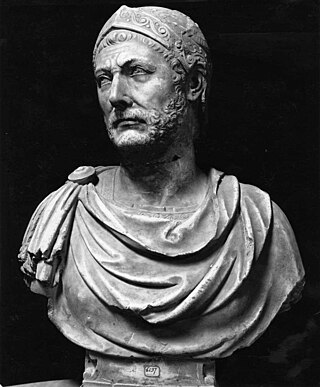
Hannibal was a Carthaginian general and statesman who commanded the forces of Carthage in their battle against the Roman Republic during the Second Punic War.

A circus is a company of performers who put on diverse entertainment shows that may include clowns, acrobats, trained animals, trapeze acts, musicians, dancers, hoopers, tightrope walkers, jugglers, magicians, ventriloquists, and unicyclists as well as other object manipulation and stunt-oriented artists. The term circus also describes the field of performance, training and community which has followed various formats through its 250-year modern history. Although not the inventor of the medium, Newcastle-under-Lyme born Philip Astley is credited as the father of the modern circus.
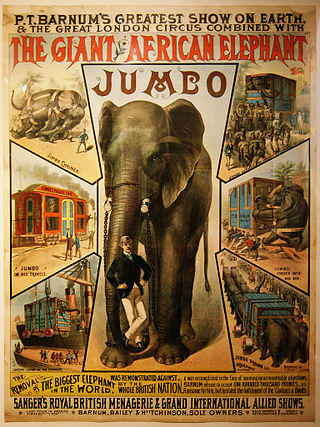
Jumbo, also known as Jumbo the Elephant and Jumbo the Circus Elephant, was a 19th-century male African bush elephant born in Sudan. Jumbo was exported to Jardin des Plantes, a zoo in Paris, and then transferred in 1865 to London Zoo in England. Despite public protest, Jumbo was sold to P. T. Barnum, who took him to the United States for exhibition in March 1882.

Topsy was a female Asian elephant who was electrocuted at Coney Island, New York, in January 1903. Born in Southeast Asia around 1875, Topsy was secretly brought into the United States soon thereafter and added to the herd of performing elephants at the Forepaugh Circus, who fraudulently advertised her as the first elephant born in the United States. During her 25 years at Forepaugh, Topsy gained a reputation as a "bad" elephant and, after killing a spectator in 1902, was sold to Coney Island's Sea Lion Park. Sea Lion was leased out at the end of the 1902 season and during the construction of the park that took its place, Luna Park, Topsy was used in publicity stunts and also involved in several well-publicized incidents, attributed to the actions of either her drunken handler or the park's new publicity-hungry owners, Frederic Thompson and Elmer "Skip" Dundy.

The Ringling Bros. and Barnum & Bailey Circus, also known as the Ringling Bros. Circus, Ringling Bros., the Barnum & Bailey Circus, Barnum & Bailey, or simply Ringling, is an American traveling circus company billed as The Greatest Show on Earth. It and its predecessor have run shows from 1871, with a hiatus from 2017 to 2023. They operate as Ringling Bros. and Barnum & Bailey. The circus started in 1919 when the Barnum & Bailey's Greatest Show on Earth, a circus created by P. T. Barnum and James Anthony Bailey, was merged with the Ringling Bros. World's Greatest Shows. The Ringling brothers purchased Barnum & Bailey Ltd. in 1907 following Bailey's death in 1906, but ran the circuses separately until they were merged in 1919.

A menagerie is a collection of captive animals, frequently exotic, kept for display; or the place where such a collection is kept, a precursor to the modern zoo or zoological garden.
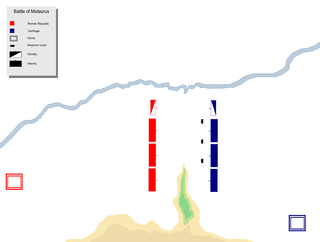
The Battle of the Metaurus was a pivotal battle in the Second Punic War between Rome and Carthage, fought in 207 BC near the Metauro River in Italy. The Carthaginians were led by Hasdrubal Barca, brother of Hannibal, who was to have brought siege equipment and reinforcements for Hannibal. The Roman armies were led by the consuls Marcus Livius, who was later nicknamed the Salinator, and Gaius Claudius Nero.
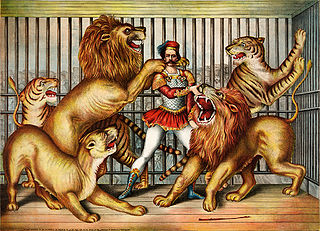
Lion taming is the taming and training of lions, either for protection or for use in entertainment, such as the circus. The term often applies to the taming and display of lions and other big cats such as tigers, leopards, jaguars, black panthers, cheetahs, and cougars. People often use lion taming as a metaphor for any dangerous activity. Lion taming occurs in zoos around the world to enable the keepers to carry out medical procedures and feedings.

George Wombwell was a famous menagerie exhibitor in Regency and early Victorian Britain. He founded Wombwell's Travelling Menagerie.
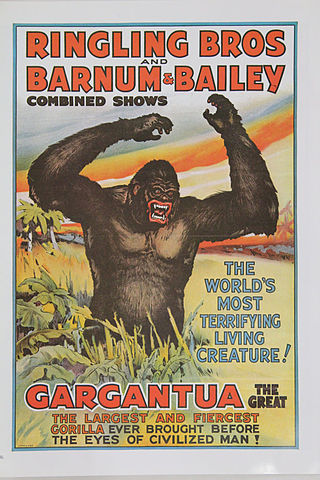
Gargantua was a captive western lowland gorilla famed for being exhibited by the Ringling Brothers circus. He has been credited with saving the business from bankruptcy. An acid scar on his face gave Gargantua a snarling, menacing expression, which the circus management exploited by generating publicity falsely exaggerating his purported hatred of humans. He was also claimed to be the largest gorilla in captivity.
Tusko is a popular name given to elephants in captivity. Several notable elephants have been given this moniker.

Woburn Safari Park is a safari park located in Woburn, Bedfordshire, England. Visitors to the park can drive through exhibits, which contain species such as southern white rhino, elephants, tigers and black bears. It is part of the estates of the Duke of Bedford that also includes Woburn Abbey and its 3,000-acre (1,200 ha) deer park. The Safari Park itself covers 360 acres (150 ha).

Al G. Barnes Circus was an American circus run by Alpheus George Barnes Stonehouse that operated from 1898 to 1938.
Ziggy was a male Indian elephant who lived at Brookfield Zoo outside Chicago from 1936 to 1975. He weighed about six tons and was over ten feet tall. After attacking and nearly killing his keeper in 1941, Ziggy was chained to the wall of an indoor enclosure, and remained there for nearly three decades. His confinement became a cause célèbre in the late 1960s, when school children and other animal enthusiasts began campaigning for his release. Ziggy was briefly allowed to go outside in 1970, and a year later, the zoo completed a new outdoor facility specifically designed for the elephant. However, Ziggy only enjoyed a few years of freedom before dying in 1975.
The British Alpine Hannibal Expedition was an experimental archeology event that took place in 1959. British engineer John Hoyte led an expedition that tried to reenact aspects of Hannibal's legendary crossing of the Alps during the Second Punic War in 218 BCE. The group successfully took the female Asian elephant Jumbo, provided by a zoo in Turin, from France over the Col du Mont Cenis into Italy.

Hannibal's crossing of the Alps in 218 BC was one of the major events of the Second Punic War, and one of the most celebrated achievements of any military force in ancient warfare.
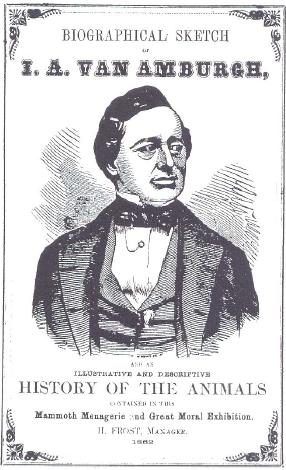
Isaac A. Van Amburgh (1808–1865) was an American animal trainer who developed the first trained wild animal act in modern times. By introducing jungle acts into the circus, Van Amburgh paved the way for combining menageries with circuses. After that, menageries began using equestrian and clown performances in circus rings. Gradually the distinction between circus and menagerie faded.
A travelling menagerie was a touring group of showmen and animal handlers who visited towns and cities with common and exotic animals. The term "menagerie", first used in seventeenth century France, was primarily used to refer to aristocratic or royal animal collections. Most visitors to travelling menageries would never have the opportunity to see such animals under other circumstances and their arrival in a town would catalyse great excitement. The shows were both entertaining and educational; in 1872 The Scotsman described George Wombwell's travelling menagerie as "[having] done more to familiarise the minds of the masses of our people with the denizens of the forest than all the books of natural history ever printed during its wandering existence."

Elephants can be found in various captive facilities such as a zoo, sanctuary, circus, or camp, usually under veterinary supervision. They can be used for educational, entertainment, or work purposes.















